Statistical Characteristics of Major Sudden Stratospheric Warming Events in CESM1-WACCM: A Comparison with the JRA55 and NCEP/NCAR Reanalyses
Abstract
1. Introduction
2. Data and Methods
2.1. Reanalyses and Model Data
2.2. Methods
3. Parallel Comparison of SSWs between the Reanalyses and CESM1-WACCM
3.1. Statistics of SSW Events
3.2. Evolution of the Stratospheric Circulation and Temperature During SSW
3.3. Evolution of Tropospheric Circulation During SSW Events
3.4. Teleconnections and Upward Propagation of Planetary Waves from the Troposphesre
3.5. Downward Impact of SSW
4. Summary and Discussion
- On average, major SSW events based on the WMO definition [8] occur 5–6 times per decade in the JRA55 and NCEP/NCAR reanalyses, which is realistically reproduced by CESM1-WACCM. The seasonal distribution of SSWs in wintertime is also well simulated, although some tiny differences between the reanalyses and the model are noticed. The SSW events in January ranks the first in the percentage (35%), followed by February; while SSW events in November ranks the last in the percentage, which is also realistically reproduced by the model. Considering the large uncertainty from the reanalyses (especially NCEP/NCAR) and the large variability in the stratosphere, the different SSW occurrence percentages between the reanalyses and the model for some months (December and March) may not indicate a poor representation of SSW events in the model. In general, the SSW percentage in midwinter from the model falls between the two reanalyses.
- The SSW absence observed in 1990s from the reanalysis can also be identified in the model data, but of a different model decade (1930s). The scarcity of SSW events in some decades might reflect the internal variability of the stratosphere. Because the historical run is an “atmosphere-ocean coupled run” experiment, the SST and sea ice are generated by the model. Therefore, the model shows a different SSW number from the reanalyses in every decade.
- The SSW intensity measured by the circumpolar easterly anomalies, the polar cap temperature anomalies, and polar cap height anomalies are nicely simulated. The overestimated duration of SSW events in an earlier WACCM version (WACCM3.5 [63]) is not seen in this version (WACCM4). Further, the model can well reproduce the downward propagation of easterly anomalies and the negative NAM represented by the positive polar cap height anomalies following the SSW onset. The polar cap warm temperature anomalies propagate from the upper stratosphere to the upper troposphere in all datasets. The enhanced wave activities evaluated by the eddy heat flux before the SSW onset are also realistically reproduced, and the suppressed wave activities after the SSW onset are fairly similar in the reanalyses and the model.
- Both the modelling and observational evidences indicate that SSWs are proceeded by the positive PNA and negative WP pattern in the troposphere, which favor the amplification and upward propagation of extratropical waves in pre-SSW periods. The model can well simulate the negative WP pattern and the positive PNA pattern before SSWs. The negative NAO develops throughout the SSW life cycle, which is simulated to be more significantly negative in the model after SSWs, and the NAO response is seemingly weaker than that of the WP pattern.
- A cold Eurasian continent–warm North American continent pattern is observed in some pre-SSW periods, while the two continents are anomalously cold in some post-SSW periods. The model can produce distribution of the 850 h Pa temperature anomalies before and after the SSW onset, including the cold Eurasia–warm North America pattern before SSW onset and cold Eurasia–cold North America following SSWs.
Author Contributions
Funding
Acknowledgments
Conflicts of Interest
References
- O’Neill, A.; Charlton-Perez, A.J.; Polvani, L.M. Stratospheric sudden warmings. In Encyclopedia of Atmospheric Science, 2nd ed.; North, G.R., Pyle, J., Zhang, F., Eds.; Elsevier: London, UK, 2014; Volume 4, pp. 30–40. [Google Scholar]
- Limpasuvan, V.; Thompson, D.W.J.; Hartmann, D.L. The life cycle of the Northern Hemisphere sudden stratospheric warmings. J. Clim. 2004, 17, 2584–2596. [Google Scholar] [CrossRef]
- Manney, G.L.; Krnney, G.; Sabutis, J.L.; Sena, S.A.; Pawson, S. The remarkable 2003–2004 winter and other recent warm winters in the Arctic stratosphere since the late 1990s. J. Geophys. Res. 2005, 110, 583–595. [Google Scholar] [CrossRef]
- Shi, C.; Xu, T.; Guo, D.; Pan, Z. Modulating effects of planetary wave 3 on a stratospheric sudden warming event in 2005. J. Atmos. Sci. 2017, 74, 1549–1559. [Google Scholar] [CrossRef]
- Scherhag, R. Die explosionsartigen Stratospherenerwarmingen des Spatwinters, 1951–1952. Ber. Deut. Wetterd. 1952, 6, 51–63. [Google Scholar]
- Matsuno, T. A dynamical model of the stratospheric sudden warming. J. Atmos. Sci. 1971, 28, 1479–1494. [Google Scholar] [CrossRef]
- McIntyre, M.E. How well do we understand the dynamics of stratospheric warming? J. Meteorol. Soc. Jpn. 1982, 60, 37–64. [Google Scholar] [CrossRef]
- Andrews, D.G.; Holton, J.R.; Leovy, C.B. Middle Atmosphere Dynamics; Academic Press: Cambridge, MA, USA, 1985; 489p. [Google Scholar]
- Charlton, A.J.; Polvani, L.M. A new look at stratospheric sudden warmings. Part I: Climatology and modeling benchmarks. J. Clim. 2007, 20, 449–469. [Google Scholar] [CrossRef]
- Limpasuvan, V.; Hartmann, D.L. Eddies and the annular modes of climate variability. Geophys. Res. Lett. 1999, 26, 3133–3136. [Google Scholar] [CrossRef]
- Black, R.X. Stratospheric forcing of surface climate in the Arctic Oscillation. J. Clim. 2002, 15, 268–277. [Google Scholar] [CrossRef]
- Karpechko, A.Y.; Charlton-Perez, A.; Balmaseda, M.; Tyrrell, N.; Vitart, F. Predicting sudden stratospheric warming 2018 and its climate impacts with a multi-model ensemble. Geophys. Res. Lett. 2018, 45, 13538–513546. [Google Scholar] [CrossRef]
- Kim, Y.J.; Flatau, M. Hindcasting the January 2009 Arctic sudden stratospheric warming and its influence on the Arctic Oscillation with unified parameterization of orographic drag in NOGAPS. Part I: Extended-range stand-alone forecast. Weather Forecast. 2010, 25, 1628–1644. [Google Scholar] [CrossRef]
- Dörnbrack, A.; Pitts, M.C.; Poole, L.R.; Orsolini, Y.J.; Nishii, K.; Nakamura, H. The 2009–2010 Arctic stratospheric winter–general evolution, mountain waves and predictability of an operational weather forecast model. Atmos. Chem. Phys. 2012, 12, 3659–3675. [Google Scholar] [CrossRef]
- Rao, J.; Ren, R.; Chen, H.; Yu, Y.; Zhou, Y. The stratospheric sudden warming event in February 2018 and its prediction by a climate system model. J. Geophys. Res. Atmos. 2018, 123, 13332–13345. [Google Scholar] [CrossRef]
- Mukougawa, H.; Sakai, H.; Hirooka, T. High sensitivity to the initial condition for the prediction of stratospheric sudden warming. Geophys. Res. Lett. 2005, 32, L08814. [Google Scholar] [CrossRef]
- Taguchi, M. Predictability of major stratospheric sudden warmings: Analysis results from JMA operational 1-month ensemble predictions from 2001/02 to 2012/13. J. Atmos. Sci. 2016, 73, 789–806. [Google Scholar] [CrossRef]
- Butler, A.H.; Polvani, L.M. El Niño, La Niña, and stratospheric sudden warmings: A reevaluation in light of the observational record. Geophys. Res. Lett. 2011, 38, L13807. [Google Scholar] [CrossRef]
- Yoden, S.; Yamaga, T.; Pawson, S.; Langematz, U. A composite analysis of the stratospheric sudden warmings simulated in a perpetual January integration of the Berlin TSM GCM. J. Meteorol. Soc. Jpn. 1999, 77, 431–445. [Google Scholar] [CrossRef]
- Rao, J.; Ren, R.; Chen, H.; Liu, X.; Yu, Y.; Yang, Y. Sub-seasonal to seasonal hindcasts of stratospheric sudden warming by BCC_CSM1.1(m): A comparison with ECMWF. Adv. Atmos. Sci. 2019, 35, 479–494. [Google Scholar] [CrossRef]
- Rao, J.; Ren, R. Varying stratospheric responses to tropical Atlantic SST forcing from early to late winter. Clim. Dyn. 2018, 51, 2079–2096. [Google Scholar] [CrossRef]
- Rao, J.; Yu, Y.; Guo, D.; Shi, C.; Chen, D.; Hu, D. Evaluating the Brewer–Dobson circulation and its responses to ENSO, QBO, and the solar cycle in different reanalyses. Earth Planet. Phys. 2019, 3, 166–181. [Google Scholar] [CrossRef]
- Holton, J.R.; Tan, H.C. The Influence of the equatorial quasi-biennial oscillation on the global circulation at 50mb. J. Atmos. Sci. 1980, 37, 2200–2208. [Google Scholar] [CrossRef]
- Naito, Y.; Taguchi, M.; Yoden, S. A parameter sweep experiment on the effects of the equatorial QBO on stratospheric sudden warming events. J. Atmos. Sci. 2003, 60, 1380–1394. [Google Scholar] [CrossRef]
- Garfinkel, C.I.; Hartmann, D.L. Effects of the El Niño–Southern oscillation and the quasi-biennial oscillation on polar temperatures in the stratosphere. J. Geophys. Res. 2007, 112, D19112. [Google Scholar] [CrossRef]
- Taguchi, M.; Hartmann, D.L. Increased occurrence of stratospheric sudden warmings during El Niño as simulated by WACCM. J. Clim. 2006, 19, 324–332. [Google Scholar] [CrossRef]
- Wei, K.; Chen, W.; Huang, R.H. Association of tropical Pacific sea surface temperatures with the stratospheric Holton-Tan Oscillation in the Northern Hemisphere winter. Geophys. Res. Lett. 2007, 34, L16814. [Google Scholar] [CrossRef]
- Rao, J.; Ren, R. Parallel comparison of the 1982/83, 1997/98 and 2015/16 super El Niños and their effects on the extratropical stratosphere. Adv. Atmos. Sci. 2017, 34, 1121–1133. [Google Scholar] [CrossRef]
- Peters, D.H.W.; Schneidereit, A.; Bügelmayer, M.; Zülicke, C.; Kirchner, I. Atmospheric circulation changes in response to an observed stratospheric zonal ozone anomaly. Atmos. Ocean 2014, 53, 74–88. [Google Scholar] [CrossRef]
- Baldwin, M.P.; Dunkerton, T.J. Propagation of the Arctic Oscillation from the stratosphere to the troposphere. J. Geophys. Res. 1999, 104, 30937–30946. [Google Scholar] [CrossRef]
- Baldwin, M.P.; Stephenson, D.B.; Thompson, D.W.J.; Dunkerton, T.J.; Charlton, A.J.; O’Nell, A. Stratospheric memory and skill of extended-range weather forecasts. Science 2003, 301, 636–640. [Google Scholar] [CrossRef]
- Thompson, D.W.J.; Wallace, J.M. Annular modes in the extratropical circulation. Part I: Month-to-month variability. J. Clim. 2000, 13, 1000–1016. [Google Scholar] [CrossRef]
- Thompson, D.W.J.; Baldwin, M.P.; Wallace, J.M. Stratospheric connection to Northern Hemisphere wintertime weather: Implications for prediction. J. Clim. 2002, 15, 1421–1428. [Google Scholar] [CrossRef]
- Stan, C.; Straus, D.M. Stratospheric predictability and sudden stratospheric warming events. J. Geophys. Res. 2009, 114, D12103. [Google Scholar] [CrossRef]
- Roff, G.; Thompson, D.W.J.; Hendon, H. Does increasing model stratospheric resolution improve extended-range forecast skill? Geophys. Res. Lett. 2011, 38, L05809. [Google Scholar] [CrossRef]
- Tripathi, O.P.; Baldwin, M.; Charlton-Perez, A.; Charron, M.; Eckermann, S.D.; Gerber, E.; Harrison, G.; Jackson, D.R.; Kim, B.-M.; Kuroda, Y.; et al. The predictability of the extratropical stratosphere on monthly time-scales and its impact on the skill of tropospheric forecasts. Q. J. R. Meteorol. Soc. 2015, 141, 987–1003. [Google Scholar] [CrossRef]
- Allen, D.R.; Coy, L.; Eckermann, S.D.; McCormack, J.P.; Manney, G.L.; Hogan, T.F.; Kim, Y.J. NOGAPS-ALPHA simulations of the 2002 Southern Hemisphere stratospheric major warming. Mon. Weather Rev. 2006, 134, 498–518. [Google Scholar] [CrossRef]
- Kim, Y.J.; Campbell, W.; Ruston, B. Hindcasting the January 2009 Arctic sudden stratospheric warming and its influence on the Arctic oscillation with unified parameterization of orographic drag in NOGAPS. Part II: Short-range data-assimilated forecast and the impacts of calibrated radiance bias correction. Weather Forecast. 2011, 26, 993–1007. [Google Scholar]
- Taguchi, M. Predictability of major stratospheric sudden warmings of the vortex split type: Case study of the 2002 southern event and the 2009 and 1989 northern events. J. Atmos. Sci. 2014, 71, 2886–2904. [Google Scholar] [CrossRef]
- Tripathi, O.P.; Baldwin, M.; Charlton-Perez, A.; Charron, M.; Cheung, J.C.H.; Eckermann, S.D.; Gerber, E.; Jackson, D.R.; Kuroda, Y.; Lang, A.; et al. Examining the predictability of the stratospheric sudden warming of January 2013 using multiple NWP systems. Mon. Weather Rev. 2016, 144, 1935–1960. [Google Scholar] [CrossRef]
- Simmons, A.; Hortal, M.; Kelly, G.; McNally, A.; Untch, A.; Uppala, S. ECMWF analyses and forecasts of stratospheric winter polar vortex breakup: September 2002 in the Southern Hemisphere and related events. J. Atmos. Sci. 2005, 62, 668–689. [Google Scholar] [CrossRef]
- Hirooka, T.; Ichimaru, T.; Mukougawa, H. Predictability of stratospheric sudden warmings as inferred from ensemble forecast data: Intercomparison of 2001/02 and 2003/04 winters. J. Meteorol. Soc. Jpn. 2007, 85, 919–925. [Google Scholar] [CrossRef]
- Rao, J.; Ren, R.C.; Yang, Y. Parallel comparison of the northern winter stratospheric circulation in reanalysis and in CMIP5 models. Adv. Atmos. Sci. 2015, 32, 952–966. [Google Scholar] [CrossRef]
- Gent, P.R.; Danabasoglu, G.; Donner, L.J.; Holland, M.M.; Hunke, E.C.; Jayne, S.R.; Lawrence, D.M.; Neale, R.B.; Rasch, P.J.; Vertenstein, M.; et al. The Community Climate System Model version 4. J. Clim. 2011, 24, 4973–4991. [Google Scholar] [CrossRef]
- Marsh, D.R.; Mills, M.J.; Kinnison, D.E.; Lamarque, J.F.; Calvo, N.; Polvani, L.M. Climate change from 1850 to 2005 simulated in CESM1(WACCM). J. Clim. 2013, 26, 7372–7391. [Google Scholar] [CrossRef]
- Ren, R.C.; Rao, J.; Wu, G.X.; Cai, M. Tracking the delayed response of the northern winter stratosphere to ENSO using multi reanalyses and model simulations. Clim. Dyn. 2017, 48, 2859–2879. [Google Scholar] [CrossRef]
- Richter, J.H.; Sassi, F.; Garcia, R.R. Toward a physically based gravity wave source parameterization in a general circulation model. J. Atmos. Sci. 2010, 67, 136–156. [Google Scholar] [CrossRef]
- Kalnay, E.; Kanamitsu, M.; Kistler, R.; Collins, W.; Deaven, D.; Gandin, L.; Iredell, M.; Saha, S.; White, G.; Woollen, J.; et al. The NCEP/NCAR 40-year reanalysis project. Bull. Am. Meteorol. Soc. 1996, 77, 437–471. [Google Scholar] [CrossRef]
- Kobayashi, S.; Ota, Y.; Harada, Y.; Ebita, A.; Moriya, M.; Onoda, H.; Onogi, K.; Kamahori, H.; Kobayashi, C.; Endo, H.; et al. The JRA-55 reanalysis: General specifications and basic characteristics. J. Meteorol. Soc. Jpn. 2015, 93, 5–48. [Google Scholar] [CrossRef]
- Martineau, P.; Son, S.-W.; Taguchi, M.; Butler, A.H. A comparison of the momentum budget in reanalysis datasets during sudden stratospheric warming events. Atmos. Chem. Phys. 2018, 18, 7169–7187. [Google Scholar] [CrossRef]
- Gerber, E.P.; Martineau, P. Quantifying the variability of the annular modes: Reanalysis uncertainty vs. sampling uncertainty. Atmos. Chem. Phys. 2018, 18, 17099–17117. [Google Scholar] [CrossRef]
- Rao, J.; Ren, R.; Xia, X.; Shi, C.; Guo, D. Combined impact of El Niño–Southern Oscillation and Pacific Decadal Oscillation on the northern winter stratosphere. Atmosphere 2019, 10, 211. [Google Scholar] [CrossRef]
- Butler, A.H.; Seidel, D.J.; Hardiman, S.C.; Butchart, N.; Birner, T.; Match, A. Defining sudden stratospheric warmings. Bull. Am. Meteorol. Soc. 2015, 96, 1913–1928. [Google Scholar] [CrossRef]
- Thiéblemont, R.; Ayarzagüena, B.; Matthes, K.; Bekki, S.; Abalichin, J.; Langematz, U. Drivers and surface signal of interannual variability of boreal stratospheric final warmings. J. Geophys. Res. Atmos. 2019, 124, 5400–5417. [Google Scholar] [CrossRef]
- Rao, J.; Ren, R. A decomposition of ENSO’s impacts on the northern winter stratosphere: Competing effect of SST forcing in the tropical Indian Ocean. Clim. Dyn. 2016, 46, 3689–3707. [Google Scholar] [CrossRef]
- Dai, Y.; Tan, B.K. The western Pacific pattern precursor of major stratospheric sudden warmings and the ENSO modulation. Environ. Res. Lett. 2016, 11, 124032. [Google Scholar] [CrossRef]
- Hu, J.G.; Li, T.; Xu, H.M.; Yang, S.Y. Lessened response of boreal winter stratospheric polar vortex to El Niño in recent decades. Clim. Dyn. 2017, 49, 263–278. [Google Scholar] [CrossRef]
- Polvani, L.M.; Sun, L.; Butler, A.H.; Richter, J.H.; Deser, C. Distinguishing stratospheric sudden warmings from ENSO as key drivers of wintertime climate variability over the North Atlantic and Eurasia. J. Clim. 2017, 30, 1959–1969. [Google Scholar] [CrossRef]
- Wallace, J.M.; Gutzler, D.S. Teleconnections in the geopotential height field during the northern hemisphere winter. Mon. Weather Rev. 1981, 109, 784–812. [Google Scholar] [CrossRef]
- Hu, J.G.; Ren, R.C.; Xu, H.M. Occurrence of winter stratospheric sudden warming events and the seasonal timing of spring stratospheric final warming. J. Atmos. Sci. 2014, 71, 2319–2334. [Google Scholar] [CrossRef]
- Butler, A.H.; Sjoberg, J.P.; Seidel, D.J.; Rosenlof, K.H. A sudden stratospheric warming compendium. Earth Syst. Sci. Data 2017, 9, 63–76. [Google Scholar] [CrossRef]
- Wang, H.Z.; Rao, J.; Sheng, C.; Wang, B. Statistical characteristics of the Northern Hemisphere stratospheric sudden warming and its seasonality (1948–2015). Trans. Atmos. Sci. 2019, 42. (In Chinese) [Google Scholar] [CrossRef]
- de la Torre, L.; Garcia, R.R.; Barriopedro, D.; Chandran, A. Climatology and characteristics of stratospheric sudden warmings in the whole atmosphere community climate model. J. Geophys. Res. Atmos. 2012, 117, D04110. [Google Scholar] [CrossRef]
- Baldwin, M.P.; Dunkerton, T.J. Stratospheric harbingers of anomalous weather regimes. Science 2001, 294, 581–584. [Google Scholar] [CrossRef] [PubMed]
- de la Cámara, A.; Birner, T.; Albers, J.R. Are sudden stratospheric warmings preceded by anomalous tropospheric wave activity? J. Clim. 2019. [Google Scholar] [CrossRef]
- Garfinkel, C.I.; Benedict, J.J.; Maloney, E.D. Impact of the MJO on the boreal winter extratropical circulation. Geophys. Res. Lett. 2014, 41, 6055–6062. [Google Scholar] [CrossRef]
- Rao, J.; Ren, R.C. Asymmetry and nonlinearity of the influence of ENSO on the northern winter stratosphere: 1. Observations. J. Geophys. Res. 2016, 121, 9000–9016. [Google Scholar] [CrossRef]
- Rao, J.; Ren, R.C. Asymmetry and nonlinearity of the influence of ENSO on the northern winter stratosphere: 2. Model study with WACCM. J. Geophys. Res. 2016, 121, 9017–9032. [Google Scholar] [CrossRef]
- Maycock, A.C.; Hitchcock, P. Do split and displacement sudden stratospheric warmings have different annular mode signatures? Geophys. Res. Lett. 2015, 42, 10943–10951. [Google Scholar] [CrossRef]
- Peters, D.H.W.; Schneidereit, A.; Karpechko, A.Y. Enhanced stratosphere/troposphere coupling during extreme warm stratospheric events with strong polar-night jet oscillation. Atmosphere 2018, 9, 467. [Google Scholar] [CrossRef]
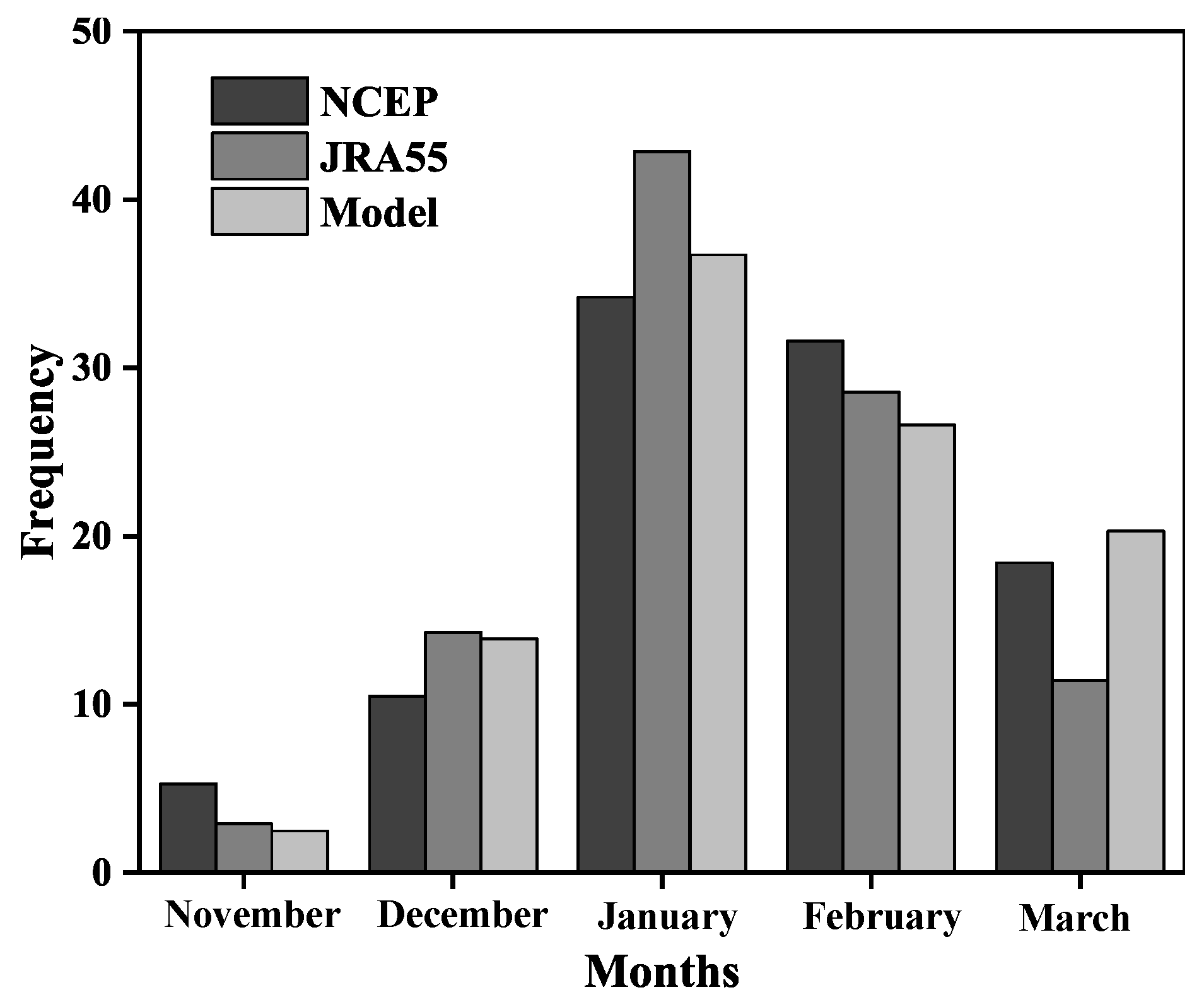
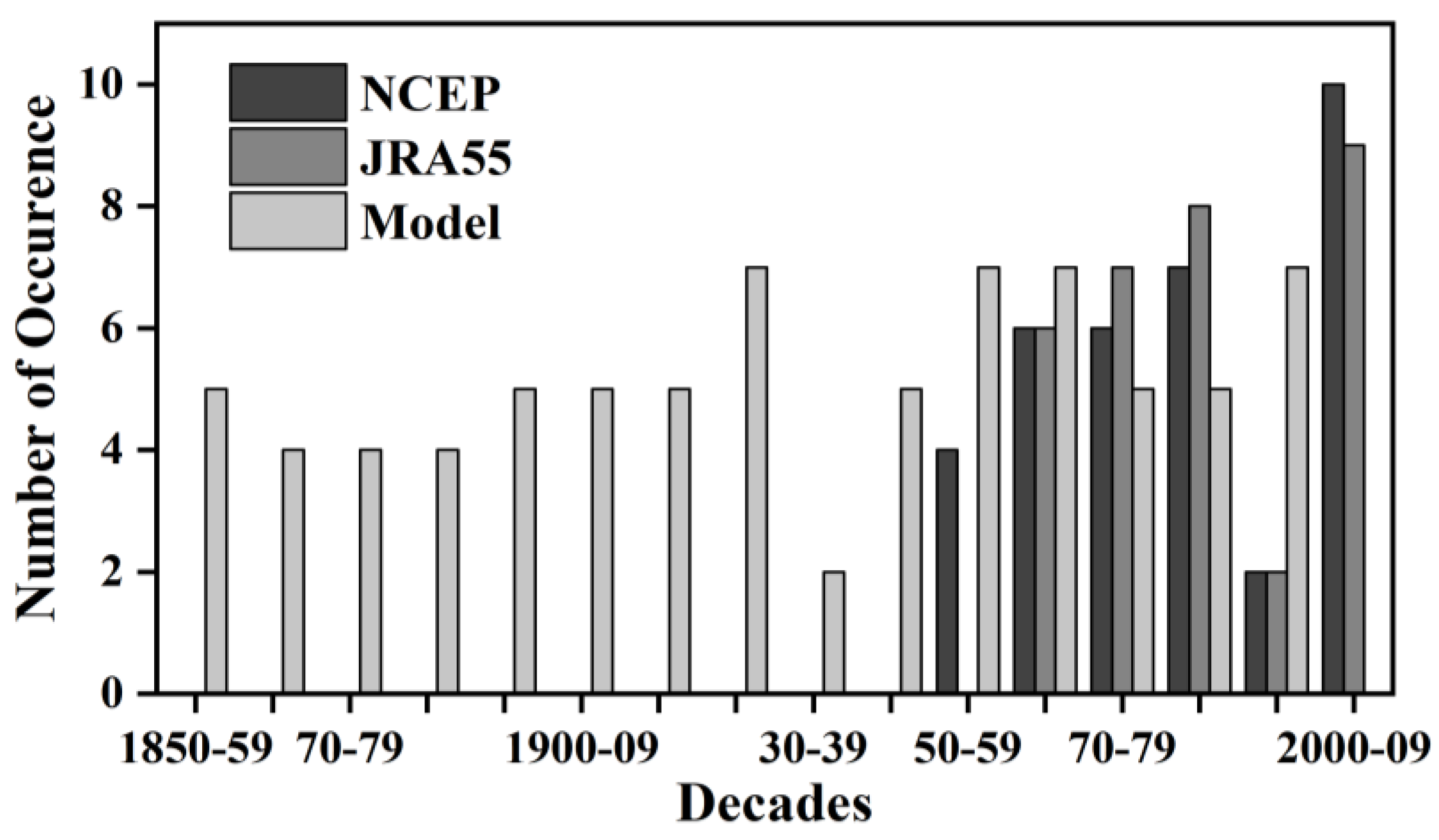
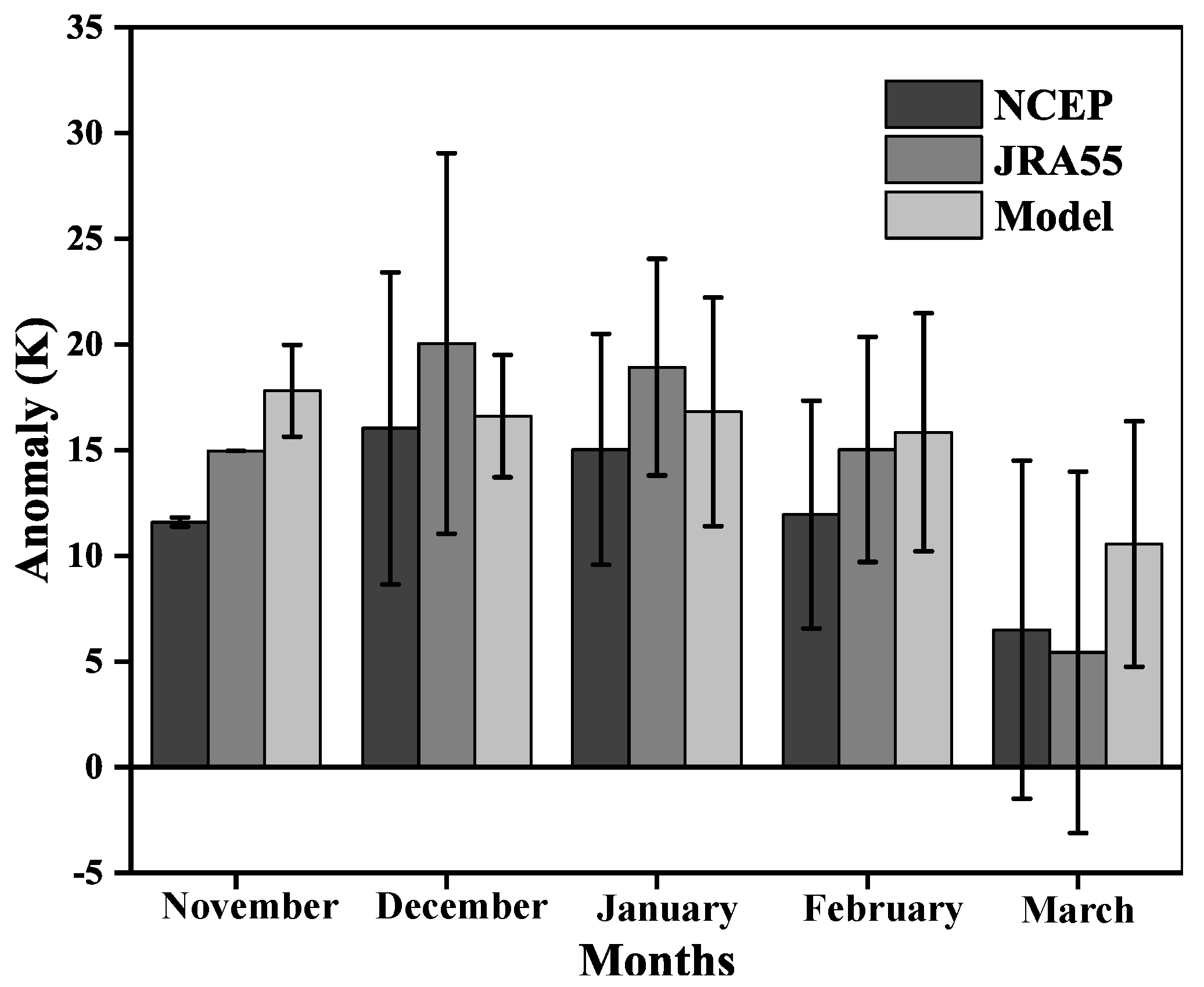
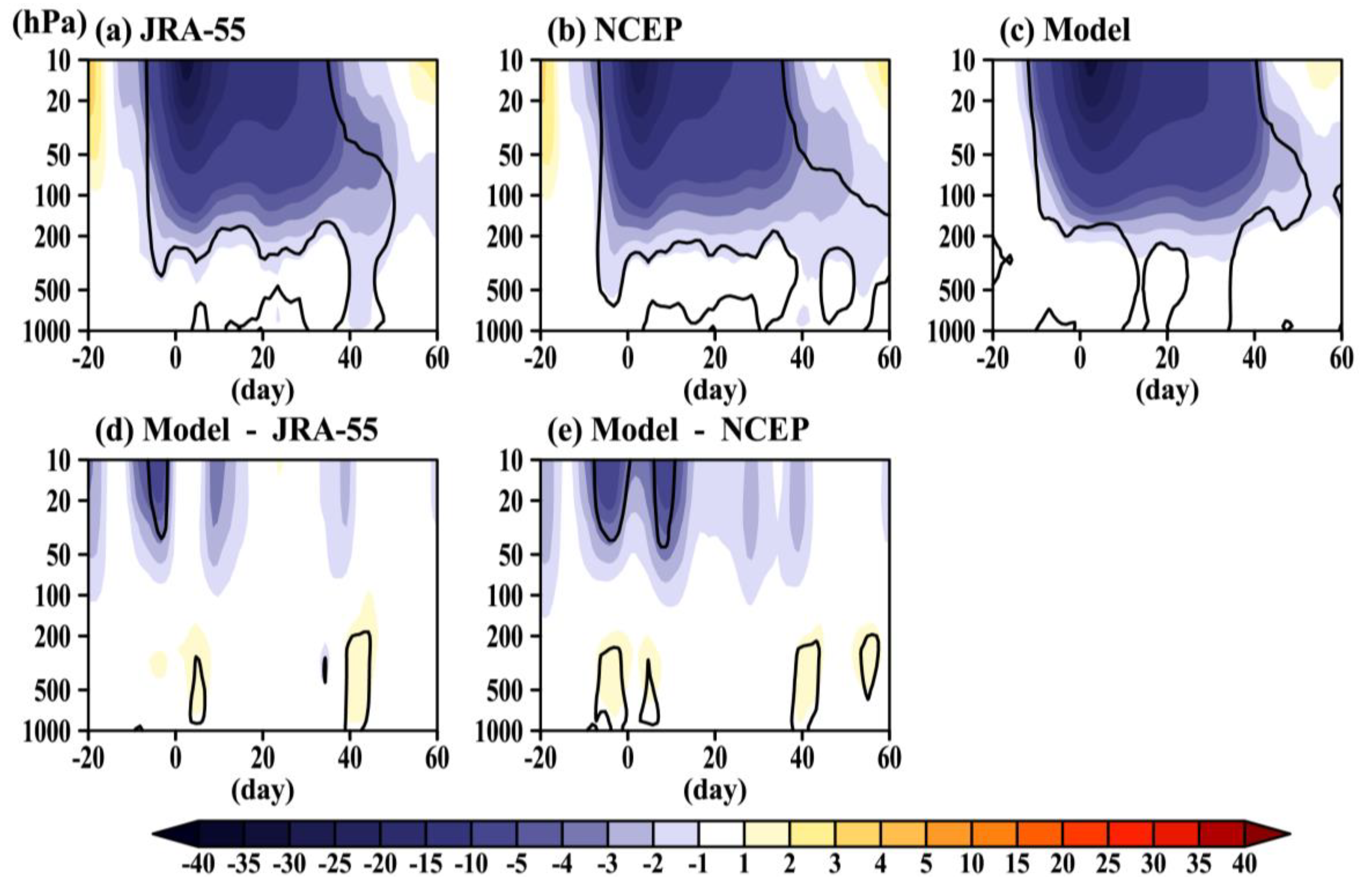
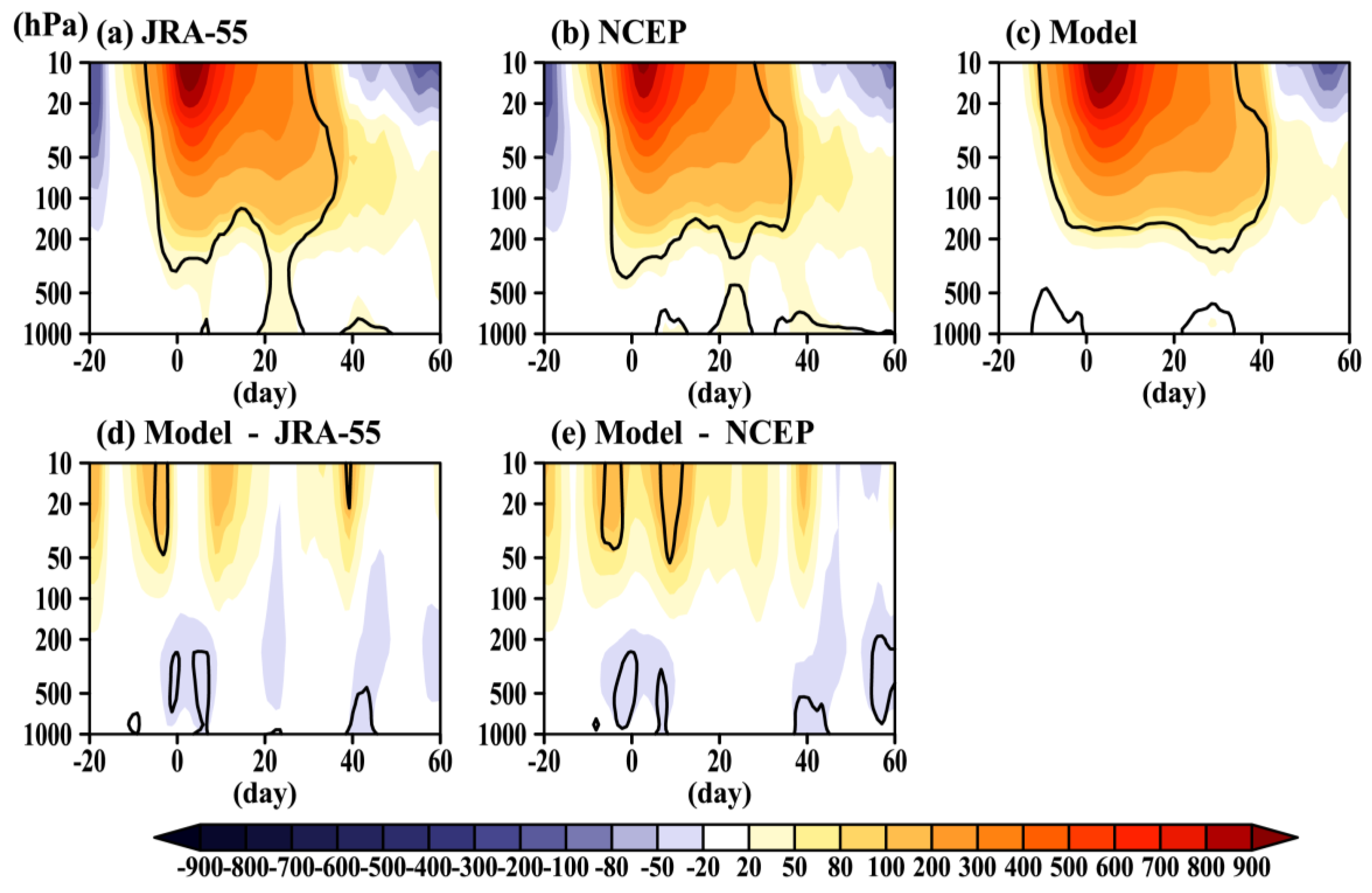
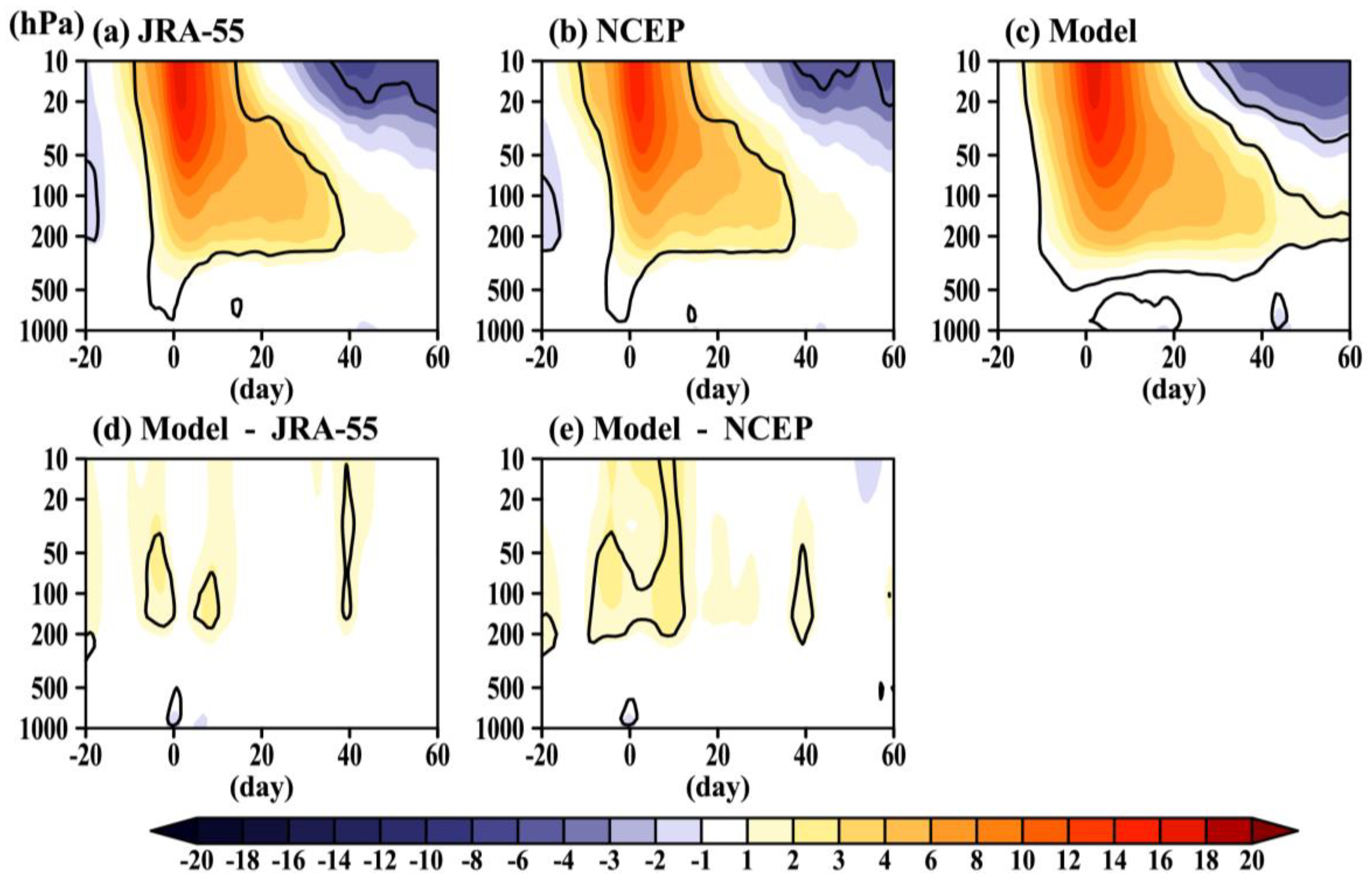
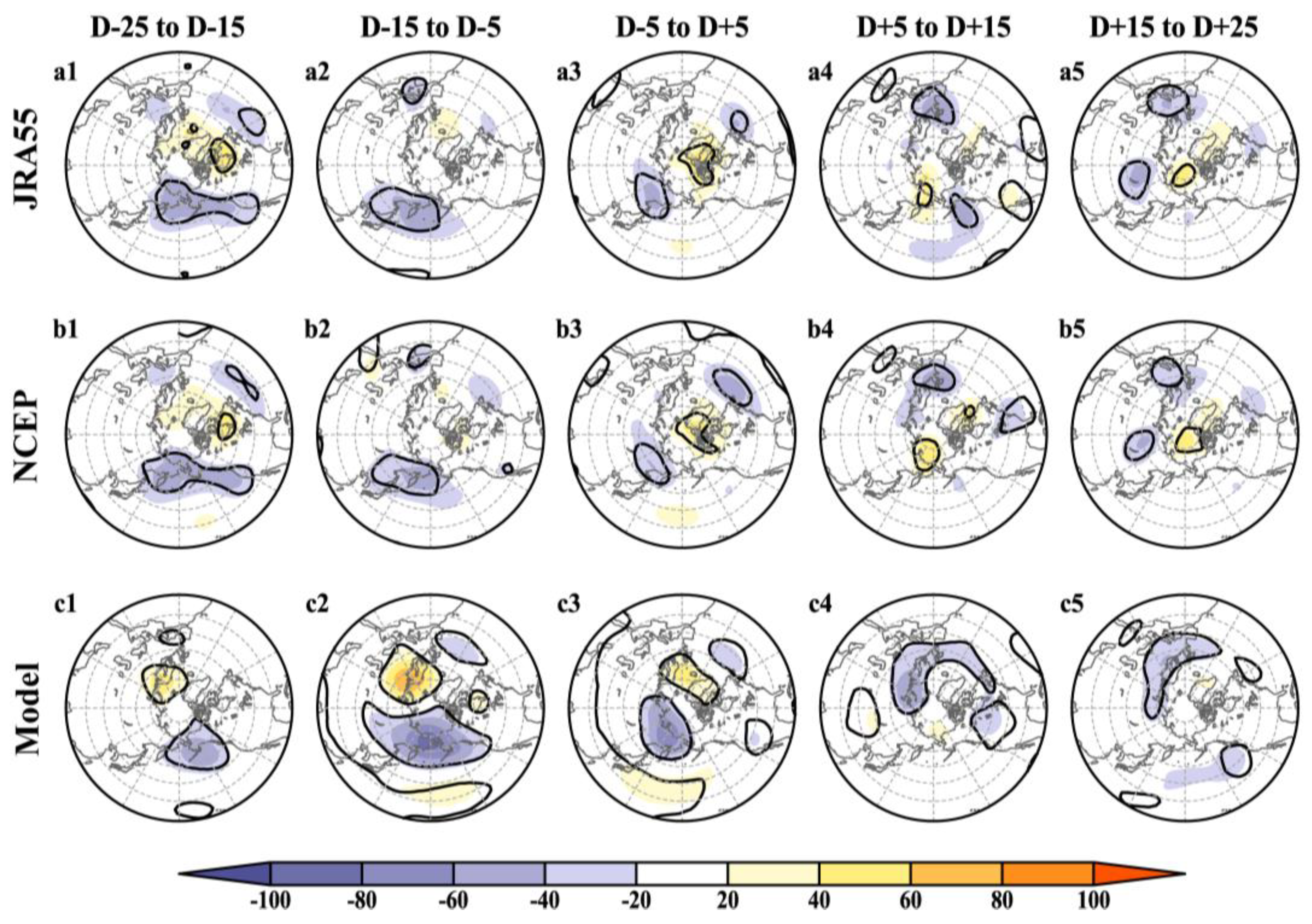

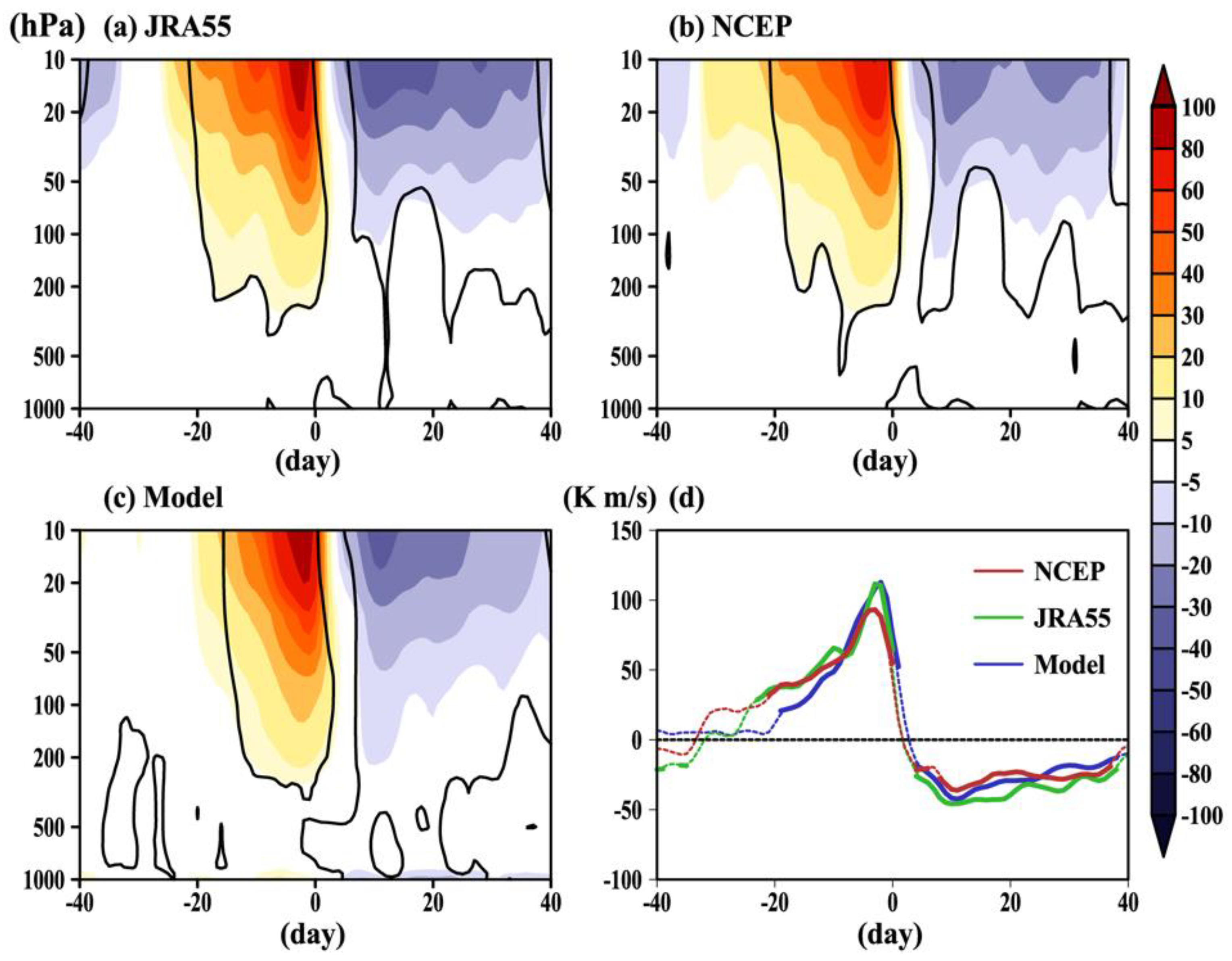
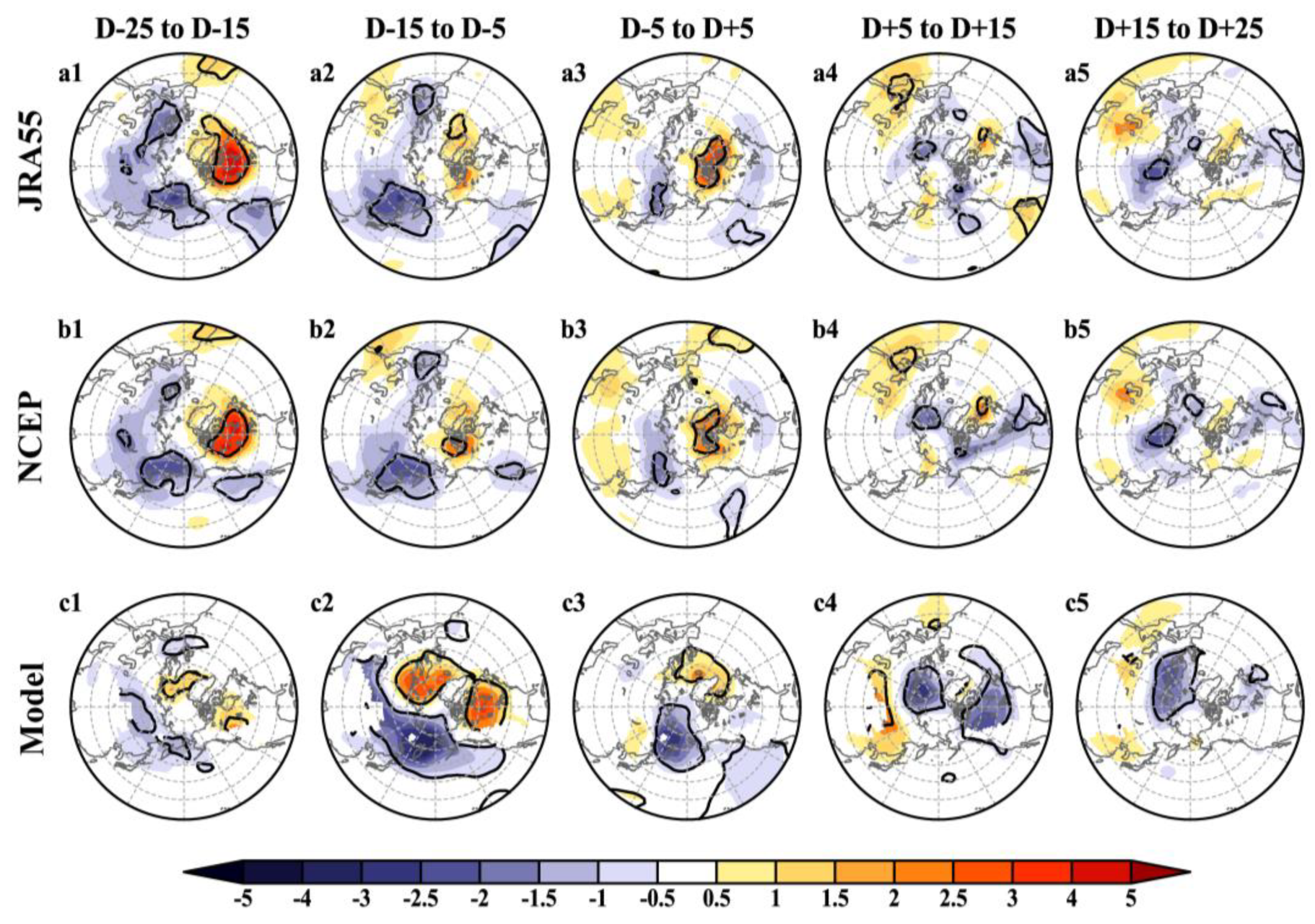
| Date in JRA55 | Date in NCEP/NCAR | Date in CESM1-WACCM | |
|---|---|---|---|
| 25 February 1952 | 2 March 1851 | 7 February 1930 | |
| 8 February 1957 | 20 March 1853 | 18 January 1936 | |
| **** | 30 January 1958 | 29 December 1853 | 12 December 1941 |
| **** | 30 November 1958 | 10 January 1855 | 15 January 1945 |
| 17 January 1960 | 16 January 1960 | 22 March 1855 | 3 December 1947 |
| 30 January 1963 | **** | 28 January 1860 | 19 February 1948 |
| **** | 23 March 1965 | 28 March 1862 | 28 January 1949 |
| 18 December 1965 | 8 December 1965 | 15 January 1865 | 19 March 1952 |
| 23 February 1966 | 24 February 1966 | 19 March 1867 | 6 January 1953 |
| 7 February 1968 | **** | 26 January 1874 | 18 March 1953 |
| 29 November 1968 | 27 November 1968 | 13 January 1876 | 17 March 1954 |
| **** | 13 March 1969 | 17 January 1877 | 20 February 1955 |
| 2 January 1970 | 2 January 1970 | 6 December 1877 | 24 January 1958 |
| 25 January 1970 | 25 January 1970 | 4 January 1880 | 14 January 1959 |
| 18 January 1971 | 17 January 1971 | 4 February 1880 | 21 February 1960 |
| 20 March 1971 | 20 March 1971 | 19 February 1887 | 27 November 1961 |
| 31 January 1973 | 2 February 1973 | 13 January 1889 | 18 February 1963 |
| 9 January 1977 | **** | 4 February 1889 | 31 January 1964 |
| 22 February 1979 | 22 February 1979 | 3 March 1893 | 19 March 1965 |
| 29 February 1980 | 29 February 1980 | 23 November 1894 | 28 December 1966 |
| 6 February 1981 | **** | 26 December 1896 | 7 February 1969 |
| 4 December 1981 | 4 December 1981 | 24 January 1898 | 6 January 1970 |
| 1 January 1985 | 2 January 1985 | 21 December 1899 | 17 February 1971 |
| 23 January 1987 | 23 January 1987 | 30 January 1900 | 9 March 1973 |
| 8 December 1987 | 8 December 1987 | 22 March 1901 | 19 January 1977 |
| 14 March 1988 | 14 March 1988 | 6 January 1904 | 7 January 1979 |
| 21 February 1989 | 22 February 1989 | 29 January 1906 | 4 February 1981 |
| 15 December 1998 | 15 December 1998 | 26 January 1908 | 26 January 1985 |
| 26 February 1999 | 25 February 1999 | 21 January 1910 | 3 February 1986 |
| 20 March 2000 | 20 March 2000 | 7 February 1912 | 2 March 1987 |
| 11 February 2001 | 11 February 2001 | 10 February 1914 | 27 February 1989 |
| 31 December 2001 | 2 January 2002 | 9 February 1915 | 26 March 1993 |
| 18 January 2003 | 18 January 2003 | 24 December 1917 | 12 January 1994 |
| 5 January 2004 | 7 January 2004 | 18 February 1920 | 25 February 1994 |
| 21 January 2006 | 21 January 2006 | 20 March 1920 | 18 February 1995 |
| 24 February 2007 | 24 February 2007 | 16 December 1920 | 6 March 1997 |
| 22 February 2008 | 22 February 2008 | 22 January 1922 | 8 February 1998 |
| **** | 14 March 2008 | 8 December 1924 | 10 January 1999 |
| 24 January 2009 | 24 January 2009 | 19 March 1928 | 9 February 2003 |
| 9 February 2010 | 9 February 2010 | 1 January 1929 | 14 January 2005 |
| 24 March 2010 | 24 March 2010 | ||
| 7 January 2013 | 7 January 2013 | ||
© 2019 by the authors. Licensee MDPI, Basel, Switzerland. This article is an open access article distributed under the terms and conditions of the Creative Commons Attribution (CC BY) license (http://creativecommons.org/licenses/by/4.0/).
Share and Cite
Cao, C.; Chen, Y.-H.; Rao, J.; Liu, S.-M.; Li, S.-Y.; Ma, M.-H.; Wang, Y.-B. Statistical Characteristics of Major Sudden Stratospheric Warming Events in CESM1-WACCM: A Comparison with the JRA55 and NCEP/NCAR Reanalyses. Atmosphere 2019, 10, 519. https://doi.org/10.3390/atmos10090519
Cao C, Chen Y-H, Rao J, Liu S-M, Li S-Y, Ma M-H, Wang Y-B. Statistical Characteristics of Major Sudden Stratospheric Warming Events in CESM1-WACCM: A Comparison with the JRA55 and NCEP/NCAR Reanalyses. Atmosphere. 2019; 10(9):519. https://doi.org/10.3390/atmos10090519
Chicago/Turabian StyleCao, Can, Yuan-Hao Chen, Jian Rao, Si-Ming Liu, Si-Yu Li, Mu-Han Ma, and Yao-Bin Wang. 2019. "Statistical Characteristics of Major Sudden Stratospheric Warming Events in CESM1-WACCM: A Comparison with the JRA55 and NCEP/NCAR Reanalyses" Atmosphere 10, no. 9: 519. https://doi.org/10.3390/atmos10090519
APA StyleCao, C., Chen, Y.-H., Rao, J., Liu, S.-M., Li, S.-Y., Ma, M.-H., & Wang, Y.-B. (2019). Statistical Characteristics of Major Sudden Stratospheric Warming Events in CESM1-WACCM: A Comparison with the JRA55 and NCEP/NCAR Reanalyses. Atmosphere, 10(9), 519. https://doi.org/10.3390/atmos10090519






